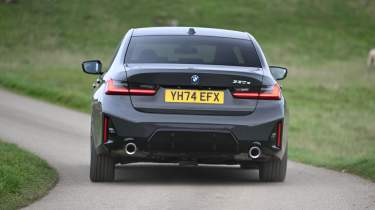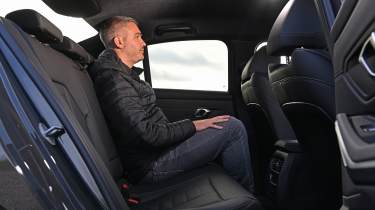BMW 330e hybrid review – the executive PHEV to beat
"The BMW 330e plug-in hybrid is satisfying to drive, comfortable, and affordable to run, especially for company car drivers"
Pros
- Good to drive
- Improved EV range
- Low BiK for business drivers
Cons
- Limited EV range
- Engine can sound strained
- Occasional hesitation
Verdict - Is the BMW 330e a good car?
If you are thinking of dipping your toe into the world of electric driving but still want the back up of a petrol engine, the updated BMW 330e is now the best plug-in hybrid on offer. It’s comfortable, good to drive and has a great interior. It’s also reasonably practical, and a much improved electric range means it’s an even better pick for company car choosers.
BMW 330e models, specs and alternatives
The BMW 330e plug-in hybrid is the electrified version of the BMW 3 Series and is available in saloon or estate form. Either way, it’s an alternative model in the range that uses additional electric power to achieve low running costs, especially for company car drivers. If you’d prefer a pure electric model, there’s the BMW i4 – although that also looks slightly different – it’s based on the BMW 4 Series Gran Coupe – and it’s only offered in a hatchback bodystyle.
The latest 330e uses a 2.0-litre turbocharged petrol engine under the bonnet, teamed with an electric motor. The battery, which can be charged up using a plug at home or at work, was made much larger for its 2024 facelift and now offers all-electric driving range of up to 63 miles – a big improvement on the 38-mile figure from before.
 Top 10 best plug-in hybrids on sale today
Top 10 best plug-in hybrids on sale today
Most of the time it has 249bhp, but in Sport mode power can be boosted to 288bhp, provided there’s enough charge in the battery. This means it’s faster than the 330e that came before, and that lines up with the sporty ethos of the BMW brand; the 330e is more enjoyable to drive than the rival Volvo V60 Recharge Hybrid or Mercedes C 300 e plug-in hybrid models.
More reviews
The main draw to the BMW 330e is its CO2 emissions, which start from just 19g/km – not much more than half of the pre-facelift 3 Series. Every version is appealing for company car drivers, though, as it delivers a much lower tax rating than solely petrol or diesel equivalents. Not only that, but this petrol-electric version is smoother, quieter and faster than the diesel versions that used to dominate the company car park, and BMW itself has discontinued the diesel 320d.
The 330e is available in Sport and M Sport trim levels, although even the entry-level models are well-equipped and good to drive. It’s roomy inside, despite the boot space being reduced to 375 litres due to the 20kWh battery pack taking up some space, which is a common trade-off with plug-in hybrid cars. An 80% charge takes two and a half hours from a home wall box, although most people will simply plug-in overnight. The plug-in hybrid 330e is sure to attract business and private customers thanks to its low running costs. While it’s more costly to buy outright than the diesel BMW 320d, the plug-in hybrid 330e is sure to attract business and private customers thanks to its low running costs.
MPG, running costs & CO2
Depending on the trim, the 330e saloon is capable of between 62 and 63 miles of pure-electric driving, which is a big improvement on the pre-facelift BMW 330e. This results in an official efficiency figure well north of 300mpg. Significantly, the emissions figure qualifies the car for a low Benefit-in-Kind (BiK) rating, potentially cutting a serious amount from your tax bill if you’re liable for paying BiK. The now-discontinued BMW 320d and the mild-hybrid 320i fall into the upper bandings of the company-car tax brackets by comparison.
While it’s debatable whether most owners will achieve triple-digit fuel economy figures – very much depending on their driving style and how often they charge its batteries – the 330e’s CO2 emissions will remain fixed for the life of the vehicle, so it should always be affordable to tax. Short to medium journeys suit the 330e best, so long-distance motorway drivers may still find a diesel cheaper to run. With the petrol engine fired up, we found the 330e capable of around 40-45mpg on longer drives.
Charging the 20kWh battery pack to 100% takes just over two hours using an 11kW A/C charger, which is another upgrade for this facelift. However, anyone hoping to top up their BMW 330e at a public chargepoint will find it still lacks rapid DC charging.
Most drivers will be able to achieve an all-electric range in the mid 50s, meaning it will be possible for many to cover their commute on battery power alone.
Engines, drive & performance
While the previous BMW 330e wasn’t slow, the German brand has used its latest technology to further bolster performance for this version. The changes include an electric motor capable of unleashing an extra 40bhp when the driver selects Sport mode, bumping the car’s combined power with the 2.0-litre petrol engine from 249bhp to 288bhp.
With rear-wheel drive the 0-62mph benchmark is dispatched in 5.9 seconds, with the 330e feeling as quick as its specifications suggest. Previously, opting for BMW’s xDrive four-wheel drive system cost around £1,500 more across the range, but this option hasn’t been made available for the latest upgrade.
With both petrol and electric propulsion, you also have more choice over how the 330e drives via its driving modes. Left in its Hybrid setting, the on-board computer juggles power based on your driving style and even data from the sat-nav, while EV mode uses just electric power whenever you have enough charge . If you’re in a hurry, Sport uses the petrol engine and electric motors for maximum acceleration. You can also choose to save the battery pack’s charge for use later, relying solely on the petrol engine, but we found Hybrid quite intelligent – it doesn’t just use all the battery power straight away like in some models.
One of the few times the BMW 330e doesn’t feel quite as smooth as an EV rival is if you roll up to a roundabout and then floor the throttle – like all PHEV’s, there’s a bit of hesitation as the petrol engine wakes up. Most of the time, though, the 330e feels quick and more engaging than something like a Tesla Model 3.
Interior & comfort
At low speeds the 330e’s electric motor makes it especially refined, with tyre noise becoming the most obvious disturbance as you speed up. The 330e is one of the most refined models in the compact-executive class. It’s also pretty comfortable, soaking up most bumps well and BMW has continued to develop the suspension for its latest 2024 facelift.
There are some comfort advantages to be found here, too, because power from the high-voltage battery can be used to precondition the 330e, warming up the interior before you set off on cold days, or cooling it down in hot weather.
The 3 Series' latest facelift ushered in BMW’s new infotainment setup, which is a big upgrade that sees a 12.3-inch instrument display flow almost seamlessly into a stunning 14.9-inch central screen. This is now one of the best systems in its class, and while the climate control has also moved to the screen – a bugbear for some – these settings are always shown at the bottom of the display in a ‘Quickselect’ bar, making them simpler to adjust.
Materials dotted around the cabin are as swish looking and solid as you’d expect, with sturdy plastics and plenty of metallic trim fillets to lift the ambience. The gear selector might take a bit of getting used to for anyone more used to a larger lever, but it helps free up the centre console for storage.
As part of an update introduced in 2020, the 330e can be specced with BMW Drive Recorder, which adds a series of cameras around the bodywork. This system continuously records when the car is moving, automatically saving the footage in the event of an accident.
Trims for the 330e are Sport and M Sport, with the latter making up the majority of sales in the UK – hardly surprising considering it only costs just over £1,000 extra. Every 330e gets at least 18-inch alloy wheels, but M Sport brings a more aggressive body kit and wider grille. Inside, the M Sport ushers in darker materials for a more sporting look.
Practicality & boot space
In most ways the BMW 330e is just as practical as a regular 3 Series, with plenty of passenger space for adults to sit in comfort. In fact, the latest model has 41mm more space between the front and rear wheels (the car’s wheelbase) than the old generation, with noticeable benefits to knee room.
The battery pack is positioned underneath the rear seats, and this does have an impact on luggage space, reducing it from 480 in the BMW 320i to 375 litres. However, the BMW has retained its usable shape, while it’s also possible to fold the 40:20:40 seat backs to create more room for bulky items.
Reliability & safety
BMW finished 14th out of 32 manufacturers in our 2024 Driver Power owner satisfaction survey, so only a middling result – albeit a slight improvement. The BMW 3 Series came in an impressive 18th place out of the top 50 cars as rated by their owners, though, which bodes well – especially as the 330e’s electric components should be reliable due to the fact there are few moving parts. It came 10th for its infotainment, 14th for its interior design and 16th for its engines and gearboxes, but only managed a middling 28th for overall value and running costs.
The 330e should certainly be safe, thanks to a five-star rating from the independent crash-test body Euro NCAP. It comes fitted with the latest safety devices as standard, which include autonomous emergency braking with pedestrian detection and lane-departure warnings.
























